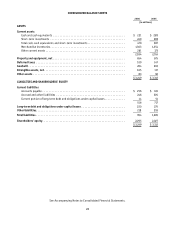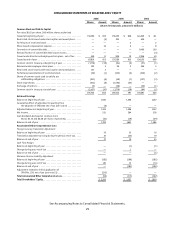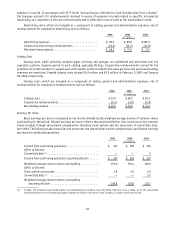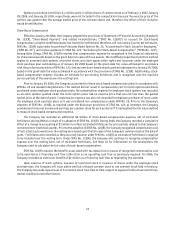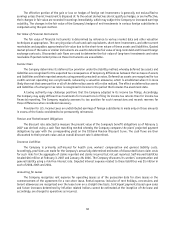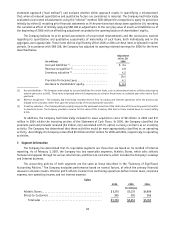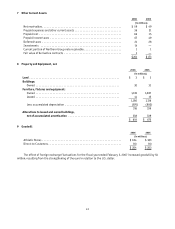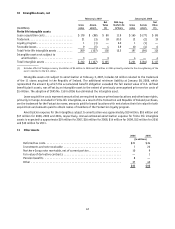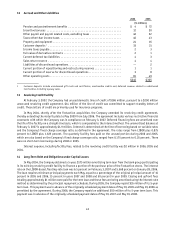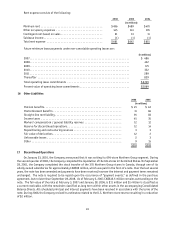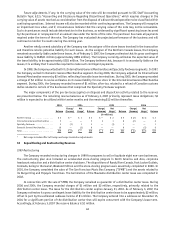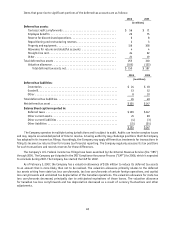Foot Locker 2006 Annual Report Download - page 54
Download and view the complete annual report
Please find page 54 of the 2006 Foot Locker annual report below. You can navigate through the pages in the report by either clicking on the pages listed below, or by using the keyword search tool below to find specific information within the annual report.
38
statement approach (“dual method”) and evaluate whether either approach results in quantifying a misstatement
that, when all relevant quantitative and qualitative factors are considered, is material. The Company had historically
evaluated uncorrected misstatements using the “rollover” method. SAB 108 permits companies to apply its provisions
initially by either (i) restating prior financial statements as if the provisions had always been applied or (ii) recording
the cumulative effect of initially applying SAB 108 as adjustments to the carrying value of assets and liabilities as of
the beginning of 2006 with an offsetting adjustment recorded to the opening balance of shareholders’ equity.
The Company believes its prior period assessments of uncorrected misstatements and the conclusions reached
regarding its quantitative and qualitative assessments of materiality of such items, both individually and in the
aggregate, were appropriate. These items did not significantly affect 2005 or 2004 as these items originated in earlier
periods. In accordance with SAB 108, the Company has adjusted its opening retained earnings for 2006 for the items
described below.
(in millions)
Adjustment
at Jan. 29,
2006
Accrued liabilities (1) ........................ $ 3.4
Revenue recognition (2) ...................... 2.8
Inventory valuation (3) ...................... 4.2
10.4
Provision for income taxes ................... 4.1
Decrease to shareholders’ equity ............... $ 6.3
(1) Accrued liabilities – The Company understated its accrued liabilities for certain items, such as telecommunications, utilities and property
taxes in years prior to 2003. These items originated when the Company was accruing for these items on a calendar year rather than a fiscal
year basis.
(2) Revenue recognition – The Company had historically recorded revenue from its catalog and Internet operations when the product was
shipped to the customer, rather than upon the actual receipt of the product by the customer.
(3) Inventory valuation – The Company did not properly recognize the permanent reduction of the retail value of its inventory upon the transfer
to clearance stores. The Company provided a reserve for the value of this inventory that had not been marked down to current selling
prices.
In addition, the Company had historically included its lease acquisition costs of $8 million in 2005 and $17
million in 2004 within the investing section of the Statement of Cash Flows. In 2005, the Company classified the
premiums paid and proceeds received ($3 million, net) associated with its option currency contracts as an investing
activity. The Company has determined that these activities would be more appropriately classified as an operating
activity. Accordingly, the Company reclassified $5 million and $17 million for 2005 and 2004, respectively, to operating
activities.
3 Segment Information
The Company has determined that its reportable segments are those that are based on its method of internal
reporting. As of February 3, 2007, the Company has two reportable segments, Athletic Stores, which sells athletic
footwear and apparel through its various retail stores, and Direct-to-Customers, which includes the Company’s catalogs
and Internet business.
The accounting policies of both segments are the same as those described in the “Summary of Significant
Accounting Policies.” The Company evaluates performance based on several factors, of which the primary financial
measure is division results. Division profit reflects income from continuing operations before income taxes, corporate
expense, non-operating income, and net interest expense.
Sales
2006 2005 2004
(in millions)
Athletic Stores....................................... $5,370 $5,272 $4,989
Direct-to-Customers .................................. 380 381 366
Total sales ....................................... $5,750 $5,653 $5,355


